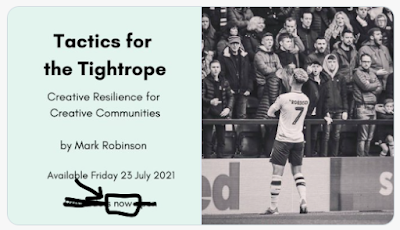Well, it’s publication day for Tactics for the Tightrope. Thanks to everyone who pre-ordered it, and everyone who’s signed up for the Substack newsletter that will replace this blog. You wise, kind people may get an adapted version of this post through that channel, along with an article written for Arts Professional. Apologies for repetition in your inbox, but I wanted to round off here with something about the book. (To read that article, you’ll need to subscribe to either Tactics for the Tightrope or Arts Professional.)
The idea to put together a book came to me one sleepless night last August. For a number of years something along these lines had lain undisturbed in the folder marked ‘THINGS TO DO IF THE WORK DRIES UP’, a folder I had been consistently happy to do no more than stuff scraps of ideas into. (The outline of my Brexit Country and Western Spoken Word Musical ‘Don’t Leave The Leaving Up To Me’ is still available, producers!) But as I lay awake, fretful about Covid, family and furlough, Brexit, the need for BLM and the world in general, and the work I had on amidst it all, I started to join the dots between various elements of the work I’d done through Thinking Practice over the last decade.
Somehow my brain made a leap to connect this to work I had been doing with the brilliant leaders of the Future Arts Centres network, work which had been put to one side whilst they found their way through the impacts of lockdown. Might something be repurposed to give me the stimulus to actually write this thing?
Happily, the ever-positive Annabel Turpin and Gavin Barlow, co-leads of Future Arts Centres, also thought that this would be a timely thing for many people in the cultural sector in the UK and perhaps beyond. In September we agreed to do the book. That seems ages and no time at all, and is certainly quick for the whole process. But it felt urgent to get it done – apart from the anxiety of getting Covid and disappearing. Although this is not a book about culture during/after/with Covid, we wanted to put it out ASAP so it might be useful. Be used and adapted.
Inevitably, my brain had tricked me (and maybe Annabel and Gavin) into something that was much more complex and complicated to do than I would have admitted at the start. The writing process proved not simply one of elegantly bringing together previously published or unpublished work – freelance life being good at giving me the right notes, but not necessarily in the right order. I wanted to update, research and revise in the light of experience. I wanted to put my own stamp or slant on ideas developed first alongside others. I wanted to show an argument that the overextension and inequality within the sector and for it to be coherent and easy to read. I needed to bring in some new ideas and connect to other potential sources of inspiration for those who might read the book. By nature, habit, budget and poetic leaning I am a bricoleur: someone who makes things from what is to hand. I prefer the hybrid, heterogenous, juxtaposed and borrowed, even the slightly awkward, to the pure. I have a high tolerance for ambiguity and expect people to work out applications themselves, so they fit the shape of their worlds rather than mine. But this also needed to be practical.
This was harder than I thought. A lot harder. I came up against all the things I didn’t know enough about, all the things I thought I knew about but didn’t, all the things I’d got wrong or changed my mind on. All the things I thought would finally expose me as an imposter. All the things I didn’t have time to learn or do or research or synthesise adequately. All the things I was not the right person to say. Not to mention the to and fro of design and proofing. Yes, it was stressful, and became a more personal project in some ways. Just this week I came across a phrase in The Hundreds by Lauren Berlant and Kathleen Stewart (brilliant book, by the way) that rang a bell about writing at such length and pitch: ‘A Repetitive Strain Injury turned into a personal tendency.’ There were times I wondered what I was doing.
Fortunately, lots of people helped with reading parts and helpful suggestions and some reassurance and encouragement. This meant the process was also rewarding and had some ‘breakthrough moments’, and satisfying as it came together. I so hope it is useful to those that read it. Doing this alongside ongoing Thinking Practice work, during a pandemic, was both a bit daft and absolutely necessary. I can see imperfections and limitations, but I have never published anything that was not true of. So it goes.
Massive thanks to Annabel and Gavin of Future Arts Centres for backing the idea. They, Becca Pratt at the Albany Lisa Taylor at ARC, and designer Jason Barningham, all worked hard to get the book ready for publication. Do please order a copy if you can for Future Arts Centres's sake, not mine. If you find it useful, buy your friend/CEO/chair/board a copy too if you can. (A digital version will be available online free in October, and we’ll share some extracts before then.)
Now I’m off to learn how to actually walk the tightrope, I think that might be easier…

Comments
Post a Comment